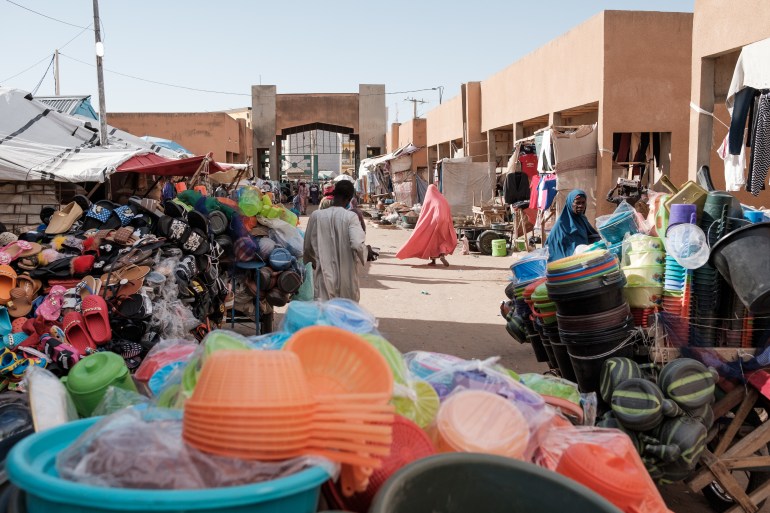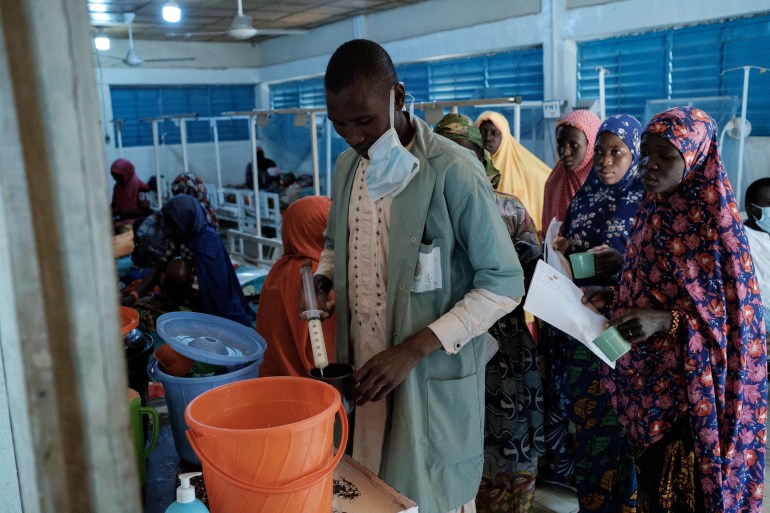A year into Ukraine war, food prices rise and aid drops in Niger
Maradi, Niger – As butchers chop meat, boys push carts of coconuts and fragrant spices entice passersby in the main market of Maradi, Niger’s second-largest city, many residents agree on one thing: life is more expensive this year than last.
A litre of cooking oil that once went for 700 CFA francs ($1.13) now goes for 1,050 CFA ($1.70), says one merchant. Aminu Maman, who sells salt, cowpeas and dried baobab fruit says demand has also drastically reduced for his items. “Almost everything is going up.”
Another merchant, Shamsudin Harouna, says that for locally grown staples like maize and sorghum, “even at the time of harvest, all the cereal items are getting more and more expensive”.
Standing next to a knee-high bucket of peanuts, Harouna says the locally grown staple has risen to 1,300 CFA ($2.10) for three kilogrammes, up from 1,000 last year. He offers up multiple explanations: people crossing the border, just 40 kilometres away, to sell their produce in neighbouring Nigeria, Africa’s largest economy. Or capital-lush wholesalers gobbling up the market before smaller merchants get a chance, leaving remaining supplies low.
And “fertiliser is too expensive”, he adds.
A year after Russia’s invasion of Ukraine, the effects are still being felt across the world as inflated prices eat into the budgets of consumers, government and aid agencies in Niger – one of the world’s poorest countries.

‘Needs are growing’
Before the invasion, Russia exported 16 percent of the world’s supply of fertiliser. Amid the war, it announced export restrictions to prop up domestic supplies. While fertiliser was not targeted by Western sanctions, “shipping companies, as well as Western financing and vessel insurance companies, steered away from Russia amid international financial sanctions and safety concerns,” according to a US government report from the Federal Reserve Bank of St Louis.
Markets for natural gas, a key component in fertiliser production, have swung wildly since the start of the war in February 2022.
Things have been tough in Niger long before Vladimir Putin ordered troops into Ukraine.
Climate change is making farming – already difficult in Niger’s semi-arid environment – even harder. With a gross domestic product (GDP) per capita of $595, Niger ranks 189th out of 191 countries on the United Nations Human Development Index, and the economy already strains to support its 25 million citizens, a population on track to hit 70 million by 2050.
While prices for some goods have increased, year-on-year inflation each month has remained at between 3-5 percent, far lower than some other countries in the region. Sierra Leone hit 35 percent year-on-year inflation in November, and in Nigeria, inflation was 21.47 percent by the end of 2022.
But things are still bad enough.
Last year, NGOs and charities across the world announced programme cuts, with resources eaten up by the war that is also affecting Maradi, the country’s economic capital. While the United States sent humanitarian assistance to Ukraine from separate budgets, Sweden, Denmark and the United Kingdom, announced they would divert humanitarian funding worldwide to shore up assistance to Ukraine last year.
Even in NGOs that were able to stave off budget cuts, there was no increase in aid funding last year as humanitarian conditions worsened and living costs went up, Ilaria Manunza, Niger Country director for Save the Children, told Al Jazeera.
“Needs are there, needs are growing and the level of funding is the same if not lower” in humanitarian operations in Niger, she said. “We haven’t seen any increase in budget despite the very needy situation. We were expecting a little bit more funding from some donors that didn’t necessarily come.”
Worldwide, many nonprofits have been able to stave off the worst of cuts since bulk orders for fuel and supplies are typically placed a year in advance, said Charlotte Schneider, director of operations at Action Against Hunger.
Donor attention, diverted to Ukraine, has also started to even out, Schneider added. But even if donor funds have evened out to pre-Ukraine levels, the need has in many cases increased.
Bulk orders for the next year need to be placed soon, she said, as prices are still high in some areas amid global inflation.
“This is the whole conversation we’re having with our donors, to see how the inflation rate could impact the way we [run] our programmes, in terms of the number of beneficiaries, in terms of services to our beneficiaries,” Schneider said.

Aid diversion
Of the 23,000 children in the Aguié health district, more than one in four are malnourished. A tenth of them required treatment at the local hospital last year.
Doctors there warn that cases rose by 20 percent from last year and the trend is likely to continue.
Last year, “the rainy season was bad, and the small harvest that we had was destroyed by worms,” says Dr Moussa Boubacar, chief of medicine. “The year we had rains, but the accessibility of fertiliser was not easy. The bags of fertiliser went from 12,000 CFA ($19.41) to 30,000 CFA ($48.53).”
Save the Children built the paediatric unit in 2007, and funded its staff through 2020, before switching to funding extra staff during peak hunger season, ahead of harvest after each rainy season. But funding cuts from other philanthropic partners last year, including the Alliance for International Medical Action (ALIMA), mean that currently only 10 of its 58 paediatric staff are being paid.
The cuts, ALIMA said, were due to donors choosing to fund conflict-hit areas of the Sahel, rather than more stable areas like the Maradi region of Niger.
But taking in the bigger picture, Kader Issaley, Alima’s director of operations says, Ukraine looms large over all humanitarian funding. The country’s humanitarian response plan, from the United Nations Office for the Coordination of Humanitarian Affairs (OCHA), received $3.3bn in funding from donors last year, “the same amount received for all West and Central African countries.”
Meanwhile, tens of thousands of refugees have streamed into Niger in the last year alone, the majority of whom are escaping years-long conflicts in Nigeria’s north. In a refugee camp in Maradi’s Chadakori, cuts last year to the World Food Programme’s monthly cash aid have left thousands hungry, driving people to beg for food or search for scant day labour in nearby towns.
Ai Issoufou, a Nigerian refugee who arrived in Niger two years ago – and her family – now receive 35,000 CFA ($56.60) per month, down from 55,000 CFA ($88.96).
“Even before the end of the month, we’ve already spent it. It’s not enough,” she said. “The children beg [in town] for us to survive.”
“2023 is another year of extreme jeopardy for those struggling to feed their families,” a WFP spokesperson said in a statement to Al Jazeera. “The war in Ukraine comes on top of other conflicts, climate shocks and high food and fertiliser prices that are all driving up the number of people in need of food assistance.”
Issoufou and her nine children are unsure if they will ever leave Niger and return to their farm in Nigeria. Years of violence in northwest Nigeria by armed bandits operating in the countryside, from where she fled, have continued despite the state’s efforts to restore order.
“We’re going to stay here for now,” she says.




